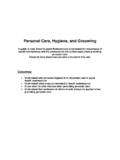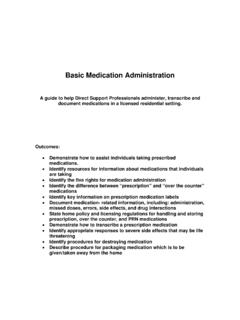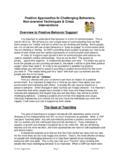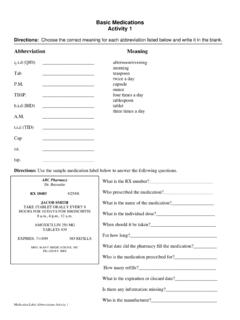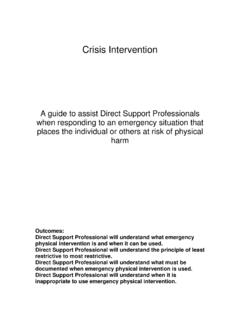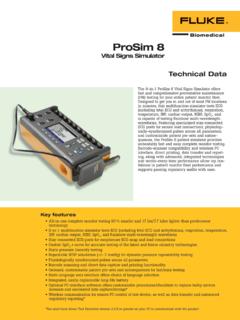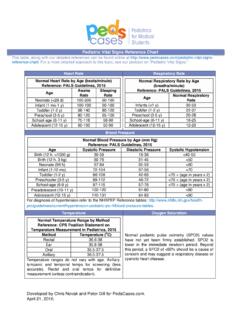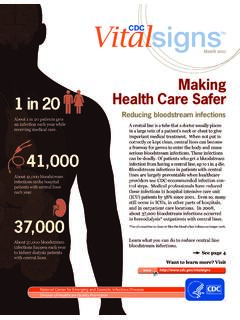Transcription of Measuring Vital Signs - Community Mental Health for ...
1 Measuring Vital Signs A guide to help Direct Support Professionals learn how to measure, and report Vital sign measurements. Outcomes: Know how to take each individual s Vital Signs . Demonstrate the correct procedure to take a temperature, pulse, respiration, and blood pressure Know the normal ranges for Adult Vital Signs Know where to record Vital Signs and report any abnormal or unusual results Measuring Vital Signs TRAINING CHECKLIST 1. Have the DSP read the unit. 2. Have the DSP complete the following worksheets: How to Read a Mercury Free or Glass Thermometer Reading the Manometer 3. Trainer will review the worksheets with the DSP. 4. Trainer will show DSP the location of equipment and supplies required to complete a set of vitals.
2 5. Trainer will demonstrate the correct procedure for taking a blood pressure, respiration, pulse and temperature. *Note: Trainer should demonstrate and have DSP practice with the equipment that is typically used in this residential setting.* 6. DSP will practice taking a set of vitals on the individuals who have agreed to assist with this training. 1. Trainer will complete Temperature, Pulse, Respirations & Blood Pressure Check Off Sheet. 2. Trainer will review documentation requirements and the procedure for reporting abnormal readings. 3. Trainer will have the DSP review each individual s plan of service and medical protocols. 4. DSP will take the test. 5. Trainer will review the test with the DSP and answer any questions.
3 Measuring Vital Signs Measuring Vital Signs In your role as a detective, you may be called upon to take an individual s Vital Signs . Vital Signs are important. They show how well the Vital organs of the body, such as the heart and lungs are working. The four Vital Signs are the individual s temperature, pulse, respiration, and blood pressure. Vitals should be taken on a regular basis: this helps you to know what is normal for the person so that you can monitor changes and recognize them as Signs or symptoms of illness. All Vital Signs should be taken when the individual is at rest. You should wait 30 minutes to take a temperature, pulse, respiration, or blood pressure if a person has just eaten, drank a hot or cold beverage, just smoked, or exercised.
4 You will receive training from a DSP trainer who has had experience taking each individuals Vital Signs . You will be trained to take Vital Signs with the equipment that is used in the residential facility in which you work. The information in this unit covers the procedure to be used for all types of equipment which may be available. Normal Ranges for Adult Vital Signs Temperature: Oral Rectal Axillary Pulse: 60 90 beats per minute Respirations: 12 28 breaths per minute Blood pressure: Systolic (top number) should be less than 130 Diastolic (bottom number) should be less than 85 Temperature Temperature is the amount of heat in the body.
5 Normal temperature is degrees F. Anything within a degree either side ( to ) is considered normal. There are various methods of taking a person s temperature. The residential setting that you work in may have any or all of the following types of thermometers: A mercury free or glass thermometer, a digital thermometer, a tympanic (ear) thermometer, or a rectal thermometer. Rectal temperatures are the most accurate but are considered to be invasive and are not usually done unless recommended by a physician. Vital Signs Page 1 2/24/2009 The easiest and most commonly used is a digital thermometer. Digital thermometers are easy to read and hard to break. Before beginning any procedure: Have equipment clean and ready Wash hands Identify the person Introduce yourself if necessary Go to a private or quiet area Explain the procedure Document your results How to take an individual s temperature using a digital thermometer: Use a plastic slip to cover the thermometer.
6 Press the button to set the thermometer. Place the thermometer under the tongue; have individual close mouth (breathing through the nose), for several minutes. Take the thermometer out of the individual s mouth to read when the temperature indicator lights. Note: If the individual is unable to keep the thermometer under his tongue, you may take an axillary temperature (under the armpit with tip of the thermometer against dry skin and held in place by the arm), waiting five minutes (not four). Do not use an oral thermometer for an individual, who has a history of seizures, breathes through his or her mouth, has just had oral surgery, or is unconscious. How to take an individual s temperature using a mercury-free thermometer or a glass thermometer: Hold the thermometer by the stem Shake the thermometer down to below the lowest number (at least below 96 degrees) before placing it under the individuals tongue.
7 To shake thermometer down, hold it at the end opposite the bulb with the thumb and two fingers. With a snapping motion of the wrist shake the thermometer. Stand away from walls and furniture to prevent accidents! Use a plastic slip to cover thermometer (if available) Place the thermometer under the tongue and to one side; have individual close mouth (breathing through the nose), for at least three minutes Remove the thermometer. Wipe with tissue from stem to bulb or remove plastic cover Hold thermometer at eye level by the stem (not the bulb). Rotate until the line appears or the colored side is facing away from you. Roll the thermometer between your thumb and forefinger, and read temperature.
8 Vital Signs Page 2 2/24/2009 Document temperature, date, time, and method used. Refer to worksheet for Reading a mercury-free or glass thermometer When doing an axillary (armpit) temperature you must leave the thermometer in place for 10 minutes How to take an individuals temperature using a tympanic thermometer: Follow manufacturers directions for use Tympanic thermometers are inserted in the ear canal A disposable ear tip should be used How to document a temperature: Always document temperature, date, time taken, and the method used. Use O for oral, R for rectal, A for axillary, and E for ear. For example: , or How to clean and care for a thermometer: Mercury-free or glass thermometers may be used to take oral, rectal, or axillary temperature.
9 Thermometers must be labeled as oral , rectal or axillary and used only for that method. Glass thermometers must be cleaned before and after each use. Each individual should also have their own thermometer labeled with their name. To clean the thermometer: Wipe off anything visible with a tissue or gauze square. Use a cotton ball or gauze square dipped in rubbing alcohol and wipe the thermometer from the cleanest to the dirtiest end Rinse the thermometer in cool water Air dry Place in container and put it away! Plastic slips or disposable sheaths may be used to cover the thermometer when taking temperatures. The thermometers must still be cleaned before and after each use Refer to manufacturer s instructions for cleaning digital and ear thermometers All digital and electronic equipment should be checked frequently for accuracy and batteries should be replaced as needed Pulse The pulse rate is the number of times the heart beats per minute.
10 Arteries carry blood from the heart to all parts of the body. A pulse is the beat of the heart felt at an artery as a wave of blood passes through the artery. You can feel a pulse every time the heart beats. You can feel a pulse most plainly over these arteries: Radial in the wrist, usually at the base of the thumb Vital Signs Page 3 2/24/2009 Carotid on each side of the neck Apical over heart with a stethoscope The easiest and most common place to measure the pulse is to feel the artery in the wrist. This area is located on the inside of the wrist on the thumb side. You will use two fingers to feel the artery.
